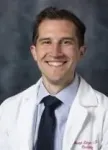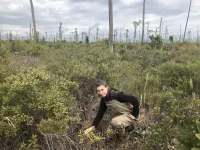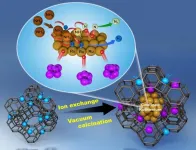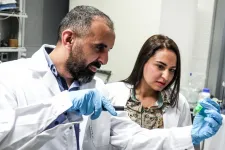(Press-News.org) LOS ANGELES (April 5, 2021) -- New research from the Smidt Heart Institute shows that more patients--specifically those with medical risk factors or from underserved communities--opted into telehealth appointments for their cardiovascular care during the COVID-19 pandemic. The data also suggests these telehealth patients underwent fewer diagnostic tests and received fewer medications than patients who saw their doctors in person.
The findings, published in JAMA (Journal of the American Medical Association) Network Open, point to "digital shifts" in cardiovascular care amid the ongoing COVID-19 pandemic.
"We were encouraged to learn that access to cardiovascular care was maintained for high-risk and underserved communities during the pandemic," said Joseph Ebinger, MD, director of Clinical Analytics in the Smidt Heart Institute and senior author of the study. "This same study, however, identified some differences in care that we need to delve into further to better understand."
The researchers examined data collected from 87,182 pre-COVID in-person visits, 74,498 COVID-era in-person visits, 4,720 COVID-era telehealth video visits and 10,381 COVID-era telephone visits.
Across all categories, patients accessing COVID-era remote visits were more likely to be from racial or ethnic minority groups, have private insurance and have cardiovascular conditions such as hypertension, coronary artery disease, atrial fibrillation and heart failure.
Researchers then compared how often medications or follow-up tests, including electrocardiograms and echocardiograms, were ordered. Findings suggest a decrease when compared to pre-COVID visits.
"Our data reveal a reduced rate of testing and prescribing, likely due to a number of factors," said Ebinger. "We see these results as being not obviously negative or positive but a trend that is important to understand. For instance, lower rates of testing and prescribing may-in many instances-reflect reductions in the types of care that are not really needed to achieve good health outcomes while adding costs to the system."
Benefits and Pitfalls of Telehealth
One of the key benefits to telehealth visits, researchers say, is access to a cardiologist at a distance, which is vital for individuals who cannot--or do not want to--travel for care due to concerns over virus exposure, lack of transportation, increased family demands or inability to take time off of work. Without telehealth visits, Ebinger said, many of these patients may well not have received any healthcare at all.
But researchers also note the importance of recognizing potential pitfalls of telehealth services, many of which disproportionately affect communities of color.
"Being a relatively new platform for patients and providers alike, there is a learning curve with telehealth, both technically and with respect to comfort and confidence," said Susan Cheng, MD, MPH, MMSc, associate professor, Cedars-Sinai Department of Cardiology, director of the Institute for Research on Healthy Aging in the Department of Cardiology at the Smidt Heart Institute, and an author on the study.
As an example, Cheng notes that patients must have access to a device that allows them to connect with their provider. Similarly, patients must be comfortable with the telehealth platform and feel confident around how to access and use it effectively.
Notwithstanding the challenges of telehealth, there are also conveniences. Researchers say past reports have indicated that racial and ethnic minority populations make up a disproportionate size of the essential job market. Essential worker schedules have been even busier during the pandemic, making it more difficult to fit in an in-person medical appointment during regular business hours. This factor could have contributed to the higher rates of telehealth use among racial and ethnic minority patients.
As a next step, researchers plan to determine whether the changes in clinician practices during the pandemic will lead to changes in patient outcomes.
"We plan to next examine if the ordering of fewer tests, such as stress tests, might predispose to missed diagnoses," said Ebinger. "To understand the balance of risks and benefits, we are also investigating whether the fewer tests ordered might actually represent opportunities to streamline away from certain types of care that were not important contributors to health in the prior system of only in-person visits."
INFORMATION:
DURHAM, N.C. -- Emily Ury remembers the first time she saw them. She was heading east from Columbia, North Carolina, on the flat, low-lying stretch of U.S. Highway 64 toward the Outer Banks. Sticking out of the marsh on one side of the road were not one but hundreds dead trees and stumps, the relic of a once-healthy forest that had been overrun by the inland creep of seawater.
"I was like, 'Whoa.' No leaves; no branches. The trees were literally just trunks. As far as the eye could see," said Ury, who recently earned a biology Ph.D. at Duke University working with professors Emily Bernhardt and Justin Wright.
In bottomlands throughout the U.S. East ...
Tsukuba, Japan - With a prevalence of about one in 10 people worldwide, chronic kidney disease (CKD) is a global health problem. It also often goes undetected, leading to a range of negative health outcomes, including death. Catching it at an early stage and adjusting nutrition and lifestyle can improve and extend life, but only if there are economically feasible systems in place to promote and educate on this.
Amid finite health-care resources, any CKD intervention must be both practical and cost-effective. A team of researchers centered at the University of Tsukuba now believe they have found a CKD behavioral intervention that can be delivered at a reasonable cost. They published their findings in the Journal of Renal Nutrition.
Changing eating and lifestyle habits, and ...
For the implementation of the effective hydrogen economy in the forthcoming years, hydrogen produced from sources like coal and petroleum must be transported from its production sites to the end user often over long distances and to achieve successful hydrogen trade between countries. Drs. Hyuntae Sohn and Changwon Yoon and their team at the Center for Hydrogen-fuel Cell Research of the Korea Institute of Science and Technology (KIST) have announced a novel nanometal catalyst, constituting 60% less *ruthenium (Ru), an expensive precious metal used to extract hydrogen via ammonia decomposition.
*Ruthenium is a metal with the atomic number 44, and is a hard, expensive, silvery-white member of the platinum group of elements.
Ammonia has recently emerged as a liquid storage and transport ...
Epidemiological studies have found that transportation noise increases the risk of cardiovascular morbidity and mortality, with high-quality evidence for ischaemic heart disease. According to the WHO, ?1.6 million healthy life-years are lost annually from traffic-related noise in Western Europe. Traffic noise at night causes fragmentation and shortening of sleep, elevation of stress hormone levels, and increased oxidative stress in the vasculature and the brain. These factors can promote vascular dysfunction, inflammation and hypertension, thereby elevating the risk of cardiovascular ...
Humans have altered the ocean soundscape by drowning out natural noises relied upon by many marine animals, from shrimp to sharks.
Sound travels fast and far in water, and sea creatures use sound to communicate, navigate, hunt, hide and mate. Since the industrial revolution, humans have introduced their own underwater cacophony from shipping vessels, seismic surveys searching for oil and gas, sonar mapping of the ocean floor, coastal construction and wind farms. Global warming could further alter the ocean soundscape as the melting Arctic opens up more ...
The world's first ground-based observations of the bare nucleus of a comet nearing the end of its active life revealed that the nucleus has a diameter of 800 meters and is covered with large grains of phyllosilicate; on Earth large grains of phyllosilicate are commonly available as talcum powder. This discovery provides clues to piece together the history of how this comet evolved into its current burnt-out state.
Comet nuclei are difficult to observe because when they enter the inner Solar System, where they are easy to observe from Earth, they heat up and release gas and dust which ...
April 06, 2020-- A new commentary published online in the Annals of the American Thoracic Society provides an exhaustive examination of published research that discusses whether air pollution may be linked to worse COVID-19 outcomes. The studies that the authors examined look at several potential disease mechanisms, and also at the relationship between pollution, respiratory viruses and health disparities.
In "COVID-19 Pandemic: A Wake-Up Call for Clean Air," Stephen Andrew Mein, MD, Department of Medicine, Beth Israel Deaconess Medical Center, Boston, and colleagues ...
A University of Guam review of published research on the critically endangered Serianthes nelsonii tree has revealed a reason why the population of the trees continues to be endangered despite a long history of funded conservation projects and a national recovery plan implemented 26 years ago. The review article, co-authored by biologists of the Plant Physiology Laboratory of UOG's Western Pacific Tropical Research Center, was published on March 2 in Horticulturae journal (doi:10.3390/horticulturae7030043).
"A main message of our paper is that decision-makers from funding agencies limit conservation success when practitioners ...
A revolutionary technology developed within the END ...
WASHINGTON, April 6, 2021 -- Home brewing enthusiasts and major manufacturers alike experience the same result of the beer-making process: mounds of leftover grain. Once all the flavor has been extracted from barley and other grains, what's left is a protein- and fiber-rich powder that is typically used in cattle feed or put in landfills. Today, scientists report a new way to extract the protein and fiber from brewer's spent grain and use it to create new types of protein sources, biofuels and more.
The researchers will present their results today at the spring meeting of the American Chemical Society (ACS). ACS Spring 2021 is being held online April 5-30. Live sessions will be hosted April 5-16, ...







